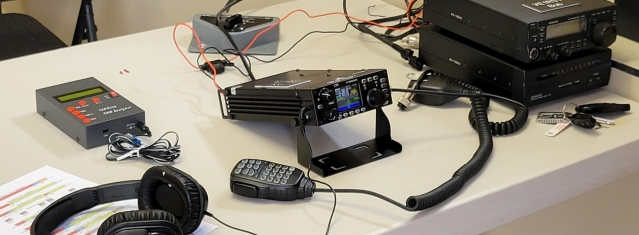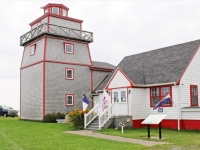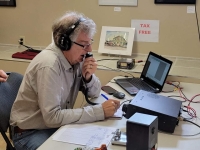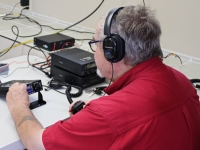Technology
The Fort Point Lighthouse Museum
Hosted Amateur Radio Event

Amateur Radio Station (Source: Brian Teepell Photography)
USPA NEWS -
The Fort Point Lighthouse Museum sits proudly on the shoreline near the mouth of the Lahave River in Lunenburg County, Nova Scotia.
The lighthouse, was active from 1876 to 1954 ,and is now a National Historic Site maintained by the Lunenburg County Historical Society. Not receiving government assistance, a group of dedicated volunteers, host fundraising events, seek donations and provide a picturesque spot for rentals which includes weddings and other private functions.
The lighthouse, was active from 1876 to 1954 ,and is now a National Historic Site maintained by the Lunenburg County Historical Society. Not receiving government assistance, a group of dedicated volunteers, host fundraising events, seek donations and provide a picturesque spot for rentals which includes weddings and other private functions.
On August 21st, 2021 which was International Light House day, the museum hosted the Lunenburg County Amateur Radio Club for a day of showcasing amateur radio communications along with the history of the Fort Point Lighthouse.
During the event, I had the chance to sit down with Ruth Seamone, President of the Lunenburg County Historical Society, who emphasized the importance of being able to provide the local community with an accurate portrait of the rich history that is within the region. She also noted that each year many visitors travel from around the Maritime provinces, other parts of Canada, and from the United States to research the legacy of their ancestors who had a connection to the area.
While exploring the grounds of this National Historic Site, on this particular day, one could see radio antennas that are not normally present and those enjoying the property were looking with curiosity.
Upon entering the community room located on the lower level of the museum building, visitors were greeted by members of the Lunenburg County Amateur Radio Club who were operating two separate Amateur Radio stations.
I had the chance to speak with the event organizer Chris Pye, VA1PYE, who told me that the purpose of this type of Amateur Radio event is to practice setting up and operating stations in non traditional locations for purpose of providing communications for special events or emergency communications in situations when infrastructure becomes congested or fails.
Most people when asked about Amateur Radio will mention worldwide communications and cryptic Morse code messages. While those aspects of the hobby are important to gaining valuable operating experience, there is much more to this fascinating hobby.
I was also able to catch up with Al Cyples, VE1CYP, who is the Lunenburg County Amateur Radio Club President, and asked the following questions:
1)As club president how would you explain the reverence of Amateur Radio in today's high-tech communication driven society.
He replied, "Although the world today is very high tech, amateur radio relies on many highly redundant technologies. Simplex can be used by amateur radio operators over quite a long distance with the RF power and antennas that most operators have today. The majority of the amateur repeaters in Nova Scotia are located at PNS sites which have backup generator power. HF communications can occur to and from any station in the world (depending on propagation and band conditions. A radio and good antenna is all that is required. I personally assisted providing backup communications after both the Swissair 111 crash in September of 1998 and also after the 9/11 event in September 2001. This was important, but secondary traffic that needed to be passed and left the Provincial Radio System free for the higher priority traffic. Most amateur radio operators are well trained and experienced operators."
2) What role does the Amateur Radio club play?
"Our Club (Lunenburg County Amateur Radio Club or LCARC for short) works closely with the local EMO coordinator to help provide support with radio communications during times of emergency or disaster. We have the use of a dedicated radio room within the Emergency Operations Centre EOC. Through the years we have also provided safety communications for canoe and bicycle races."
In his final remarks Cyples added, "A friend of mine once reminded me of a theory that has been present for many years and I still believe it to be true “When all else fails amateur radio can get through”. I also remember watching a video a few years ago with two amateur radio operators using CW and two people using text on their cell phone sending the identical message. The CW message was transmitted in a shorter period of time."
This event was successful for both the Fort Point Lighthouse Museum and the Lunenburg County Amateur Radio Club. It showcased the National Historic Site and the Amateur Radio hobby.
For more information on the Fort Point Lighthouse Museum or the Lunenburg County Amateur Radio Club, or becoming an Amateur Rado operator see the links posted below.
Fort Point Lighthouse Museum
www.fortpointmuseum.com
Lunenburg County Amateur Radio Club
http://lunenburgarc.blogspot.com/?m=1
Liability for this article lies with the author, who also holds the copyright. Editorial content from USPA may be quoted on other websites as long as the quote comprises no more than 5% of the entire text, is marked as such and the source is named (via hyperlink).









